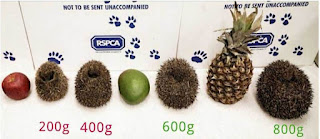GILLS HOG BLOG.
by Gill Dixon,PGCE,MA,BHScHons,RGN.
More hoglets on the way.
Hedgehogs breed between May and September but the time of greatest breeding activity is in May and June. They reach sexual maturity in their second year.
Rather strangely and possibly unwisely they attempt a second litter around September and these are less likely to do well as they have to put on an enormous amount of weight to survive the winter. Mothers too may feel compelled to hibernate if temperatures drop sharply and/or food supplies are scarce, and this will leave a number of abandoned hoglets who may need help.
Hedgehogs under 450g are unlikely to survive hibernation, but they may not hibernate at all and this is where humans can assist in their survival.
In recent years I have had hedgehogs visiting my feeding stations throughout the year , suggesting that they do not ALL hibernate perhaps because our winters have become very much milder., or perhaps because I am lucky enough to live where there is lots of natural shelter and food on tap.
Be Mindful.....
Now is the time to be very cautious if you are moving leaf piles, thinking of having a bonfire, clearing hedges, or considering your final garden tidy and getting those strimmers out.
When threatened hedgehogs do not have a fight or flight response, they simply form an impenetrable ball, but this is no match for a garden strimmer or brush cutter. Please then, start your strimming at a height of six inches, or walk through the area to be strimmed before you start.
Hedgehog nests that are disturbed rarely fair well. The mother hedgehog may abandon or kill her babies when she fears predation of her young. It is not a matter of simply relocating the family.
If you see a hedgehog out in daylight it is generally in trouble but one exception to this is a nursing Mum who may venture out to get a little extra food or gather some bedding. She will be moving with purpose and does not need to be caught.
- Are they safe where they are?
- Can I offer shelter, food and water?
- Can I monitor them?
- Is the weather reasonably mild?
- Are they alone or with a mother?
Gill, has until very recently run a busy and successful hedgehog rescue. She now devotes her time to raising awareness, offering advice, and writing articles about our beloved European Hedgehogs.



No comments:
Post a Comment